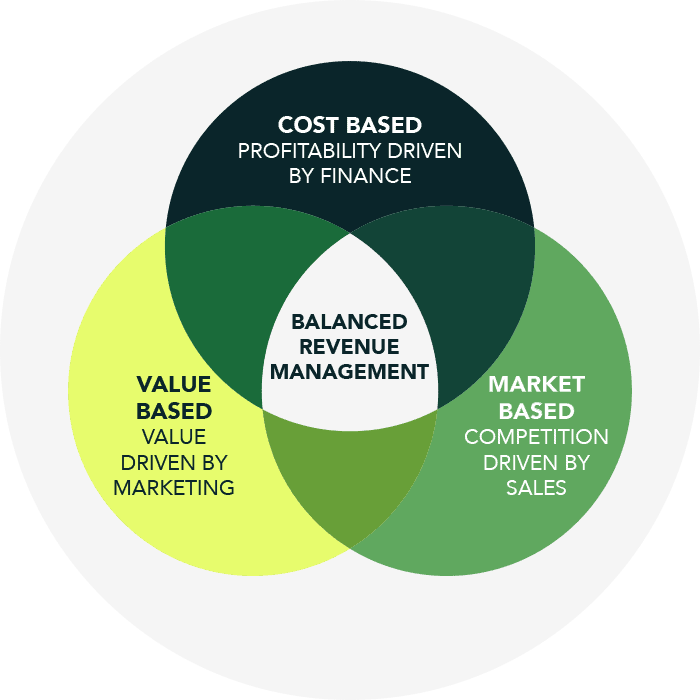Working in the field of pricing and revenue management, one of the most common questions I get is, “Where should I set my price?” Although it might seem like a relatively straight forward question, the underlying answer is anything but there are three common pricing strategies and pricing models typically employed when setting a price.
The 3 Most Common Pricing Strategies
When it comes to pricing anything (B2B, B2C, product or service), there are three key strategies to achieve price optimization:
1. Cost-based or cost-plus pricing
2. Market-based pricing
3. Value-based pricing
While there are claims of other strategies, most are offshoots or variations of these three.
1. What is a Cost-Based Pricing Example:
What is cost-based or cost-plus pricing? Surprisingly, cost-based pricing is what it sounds like: calculating the cost of a product or service and adding a standard margin to the cost. For example, if it costs $2.50 to make a widget, then a 50% standard margin would mean the widget’s price is $5.00.
2. What is a Market-Based Pricing Strategy Example:
Unlike cost-based pricing, market-based pricing takes into account competitors. Market-based pricing is when the price of a product or service is set based on its competitive market position and product market fit—essentially pricing on par with or near your competition. For example, commodities (raw materials, basic resources, agricultural, or mining products, such as iron ore, sugar, or grains like rice and wheat) often fall in this category as pricing is defined by what the market is willing to pay. Another typical market price example is companies whose pricing strategy is to be “fast-followers.” A fast-follower is a company that adjusts their prices shortly after their competitors change their prices (quickly following suit, aka fast-following).
3. What is a Value-Based Pricing Strategy Example:
Value-based pricing is the final approach and usually the most difficult to execute. This pricing strategy seeks to estimate the determined “value” of a good or service based on the buyer’s point of view and then price based on that perceived value.
A prime example of value-based pricing is business-class airline tickets. Business-class tickets offer significant value for a segment of customers—added comfort, early-boarding, meal service, arriving at destination well-rested (perceived as especially valuable on long-flights)—and airlines price these tickets accordingly.
Contact Us To Learn More About Pricing Strategies!
The Pros and Cons of Cost-Based Pricing & Other Pricing Strategies
Now that we’ve reviewed the three most used pricing strategies let’s outline the benefits and drawbacks of each in more detail.
What are the Benefits and Drawbacks of a Cost-Based Strategy?
Cost-based and cost-plus pricing is often the most popular way to set a price because it is easy to calculate, is generally objective, brings predictable margins, and doesn’t require too much effort to put in place.
Cost-oriented pricing is also readily justifiable to customers as it’s a very straightforward way of approaching price:
If a product costs x to produce, then the producer must charge x plus a margin to secure a profit.
In the consumer goods space, for example, manufacturers will often exploit this by telling tales of an increase in the cost of an essential commodity used in the production of their goods. As the good now costs more to produce, the manufacturer has found a way of passing off that price increase—real or otherwise—to the consumer.
There are, however, some critical drawbacks to the cost-based pricing model. The most glaring of which is that it is inward-focused—only taking into consideration internal cost concerns and not considering external factors like a customer’s willingness to pay a premium. For example, when you renew a passport in Canada, a five-year renewal costs $120, and the 10-year passport renewal costs $160. The customer’s perceived value and convenience of not having to return to the passport office after only five years (which can be quite high depending on individual experience) are potentially worth more than the $40 markup Service Canada charges for the 10-year passport. Service Canada could surely price higher for this convenience.
Another major drawback is the accuracy of the “cost” used to calculate the price. Often fixed costs are difficult to attribute to specific products or services within an organization. Input costs change, fixed costs get allocated differently. There are multiple reasons why cost can change within an organization, leading to:
- Customers not believing production cost to be true, and consequently not purchasing the product
- Cost estimates that are subsequently determined inaccurate, potentially leading to a miss in the desired standard margin
What are the Benefits and Drawbacks of a Market-Based Pricing Strategy?
Market-based pricing moves beyond the navel-gazing of cost-based pricing and looks externally to incorporate a pricing analysis of market conditions to set prices.
The most common use of market-based pricing is in the commodity market. For those industries which are not commodities, the reality is that market pricing is key competitor pricing. Key competitor pricing is when companies benchmark their price to their key competitors, either market leaders or those similar in terms of size and geography.
In the food services industry, for example, the market price is essential for the suppliers selling restaurants raw ingredients. Because the ingredients are a part of and not the sole focus of the meal, restaurants will often opt for the cheapest. This factor makes the market/competitor price of goods (for example, ingredients like vegetables, fruit, meat, etc.) critical to the pricing strategy.
Market-based pricing is especially beneficial to companies that have a cost advantage in the market, for example, Walmart. Due to Walmart’s cost-advantage—ability to sell products at a lower cost than their competition—they can offer prices at a market discount compared to other retailers.
But, market-based pricing does have drawbacks. Like cost-plus pricing, the market-based approach does not consider the buyer’s willingness to pay, meaning money is likely to be left on the table.
It is also of note that getting competitive market data in some industries can be complicated and unreliable, making it hard to set prices in line with your competitors. While there are services that track the competitive market price, these are often expensive and unreliable as prices are aggregated to protect privacy.
While market-based pricing gives a good outward view when compared to cost-plus pricing, it still misses the input of the buyer/customer and, consequently, the potential for additional profit.
What are the Benefits and Drawbacks of a Value-Based Pricing Strategy?
Value-based pricing moves the pricing strategy approach forward by considering the customer’s willingness to pay when setting the price of a good or service.
This approach has become very popular over the last few years, but it is also one of the most difficult to execute. Marketing departments favour this approach as it quantifies and charges for the value a product or service delivers.
The reason for its notoriety is that profitability can be maximized by extracting the most value from customers by pricing exactly what they are willing to pay. But, to be able to price based on value, one must be able to calculate the perceived value and, thus the customer’s willingness to pay. There are a few ways to do this:
- Traditional market research such as a conjoint analysis
- Statistical modelling using choice-based methodologies
- Other quantitative and qualitative methods and workshops (for example, price value mapping exercises)
The difficulty is that most companies don’t have the internal capacity to execute these activities as they require specialized skills and time. Not only is value-based pricing harder to implement than the two other pricing strategies, it is also costlier. However, the higher payoff makes value-based pricing a worthy endeavour.
Still, value-based pricing is not without its drawbacks. After all, different customers have different willingness to pay. In a perfect world, a company would be able to charge each customer a price based on their willingness to pay, (but in reality), that isn’t possible.
Segmentation is a crucial component of value-based pricing—understanding what groups of customers exist and what each specific group perceived values are when compared to others. If companies can differentiate products (for example, through versioning—version A offers three features for x price, and version B offers five features for x price), it allows them to capture a greater portion of the market, increase sales and profitability through product differentiation for different customer segments without leading to cannibalization of overall sales.
Ultimately, however, value is subjective, and in many cases, when utilizing value-based pricing, companies are estimating the hypothetical value customers will benefit from. For example, a particular car engine oil might decrease repairs by up to 20%. However, if the manufacturer sets the price based on the 20% decrease and customers only realize 5% fewer repairs, the price might not reflect the value delivered, and the company stands to lose customers.
Ultimately, however, value is subjective, and in many cases, when utilizing value-based pricing, companies are estimating the hypothetical value customers will benefit from.
Despite its benefits, value-based pricing is tough to execute, especially if other competitors are not pricing based on value. If a company pricing on value is in a competitive situation with a company pricing based on cost, it often leads to the degradation of the value equation.
While value-based pricing is a step in the right direction for most organizations, it is not an all-encompassing solution.
Contact Us To Learn More About Pricing Strategies!
Balancing Cost-Based Pricing and Market-Based Pricing Strategies
As you can see, the three most common pricing strategies all have benefits and drawbacks, and different groups in an organization prefer one over another. Ultimately, the best way to set prices is to use a balanced RM framework, which incorporates all three methodologies and takes a unified approach to price across the organization.
This balanced approach invites all key stakeholders to be part of the pricing process—finance, sales, and marketing. In doing so, companies can consider internal costs/profitability (financials), external market pressures (competition), as well as willingness to pay (customer value) in their decision-making process.
A balanced approach to pricing strategy, aided by a pricing consultant, allows your company to be more flexible with pricing and provides the opportunity to micro-optimize. For example, a company might price two very similar product lines differently based on geography/market. In one market, there may be multiple competitors (need to set price more in line with competition), while in another market, the company may hold a monopoly (can price higher).
The Balanced RM approach for pricing can deliver superior profit results for companies. In our experience, companies outperform individual pricing strategies (cost plus, value-based and market-based) by as much as 70% when using a balanced approach.
How to Choose The Right Pricing Strategy
Ultimately it is essential to remember that pricing is a journey and not a destination. Landscapes are continually evolving, so adaptability is vital regardless of your current pricing strategy.
Typically, organizations grow from market-based pricing to cost-plus and then, finally, as they mature, towards value-based pricing. As your organization grows, ensure that your pricing strategy is evolving along with that growth. Be nimble and opportunistic – evolve, adapt and take advantage of your ever-changing environment.
If you’re considering a more strategic approach to pricing for your organization, I encourage you to work with a pricing consultant who will ensure your strategy is capturing as much value as possible, in addition to helping you build your internal capabilities for sustainable profitability.
ABOUT THE AUTHOR Michael Stanisz is a Partner at Revenue Management Labs. Revenue Management Labs help companies develop and execute practical solutions to maximize long-term revenue and profitability. Connect with Michael at mstanisz@revenueml.com.





